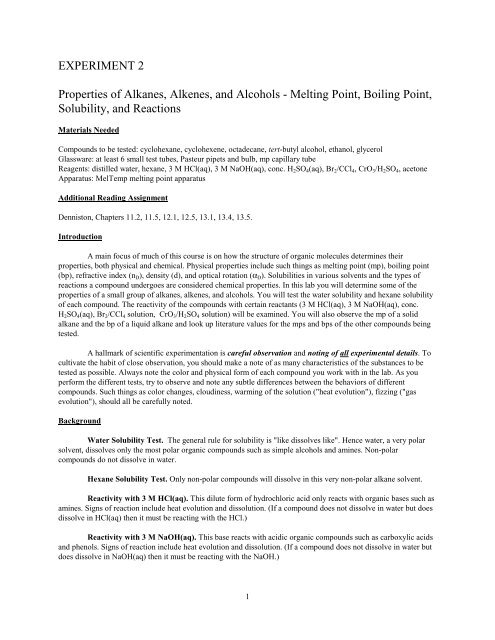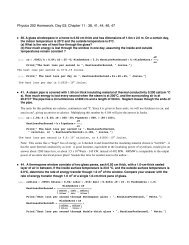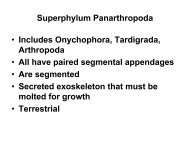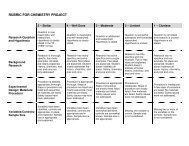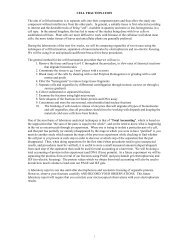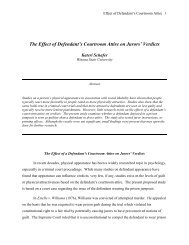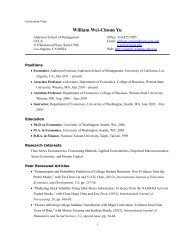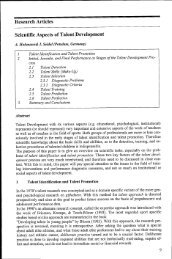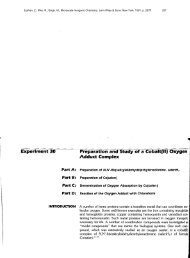EXPERIMENT 2 Properties of Alkanes, Alkenes, and Alcohols ...
EXPERIMENT 2 Properties of Alkanes, Alkenes, and Alcohols ...
EXPERIMENT 2 Properties of Alkanes, Alkenes, and Alcohols ...
You also want an ePaper? Increase the reach of your titles
YUMPU automatically turns print PDFs into web optimized ePapers that Google loves.
<strong>EXPERIMENT</strong> 2<br />
<strong>Properties</strong> <strong>of</strong> <strong>Alkanes</strong>, <strong>Alkenes</strong>, <strong>and</strong> <strong>Alcohols</strong> - Melting Point, Boiling Point,<br />
Solubility, <strong>and</strong> Reactions<br />
Materials Needed<br />
Compounds to be tested: cyclohexane, cyclohexene, octadecane, tert-butyl alcohol, ethanol, glycerol<br />
Glassware: at least 6 small test tubes, Pasteur pipets <strong>and</strong> bulb, mp capillary tube<br />
Reagents: distilled water, hexane, 3 M HCl(aq), 3 M NaOH(aq), conc. H2SO4(aq), Br2/CCl4, CrO3/H2SO4, acetone<br />
Apparatus: MelTemp melting point apparatus<br />
Additional Reading Assignment<br />
Denniston, Chapters 11.2, 11.5, 12.1, 12.5, 13.1, 13.4, 13.5.<br />
Introduction<br />
A main focus <strong>of</strong> much <strong>of</strong> this course is on how the structure <strong>of</strong> organic molecules determines their<br />
properties, both physical <strong>and</strong> chemical. Physical properties include such things as melting point (mp), boiling point<br />
(bp), refractive index (nD), density (d), <strong>and</strong> optical rotation (αD). Solubilities in various solvents <strong>and</strong> the types <strong>of</strong><br />
reactions a compound undergoes are considered chemical properties. In this lab you will determine some <strong>of</strong> the<br />
properties <strong>of</strong> a small group <strong>of</strong> alkanes, alkenes, <strong>and</strong> alcohols. You will test the water solubility <strong>and</strong> hexane solubility<br />
<strong>of</strong> each compound. The reactivity <strong>of</strong> the compounds with certain reactants (3 M HCl(aq), 3 M NaOH(aq), conc.<br />
H2SO4(aq), Br2/CCl4 solution, CrO3/H2SO4 solution) will be examined. You will also observe the mp <strong>of</strong> a solid<br />
alkane <strong>and</strong> the bp <strong>of</strong> a liquid alkane <strong>and</strong> look up literature values for the mps <strong>and</strong> bps <strong>of</strong> the other compounds being<br />
tested.<br />
A hallmark <strong>of</strong> scientific experimentation is careful observation <strong>and</strong> noting <strong>of</strong> all experimental details. To<br />
cultivate the habit <strong>of</strong> close observation, you should make a note <strong>of</strong> as many characteristics <strong>of</strong> the substances to be<br />
tested as possible. Always note the color <strong>and</strong> physical form <strong>of</strong> each compound you work with in the lab. As you<br />
perform the different tests, try to observe <strong>and</strong> note any subtle differences between the behaviors <strong>of</strong> different<br />
compounds. Such things as color changes, cloudiness, warming <strong>of</strong> the solution ("heat evolution"), fizzing ("gas<br />
evolution"), should all be carefully noted.<br />
Background<br />
Water Solubility Test. The general rule for solubility is "like dissolves like". Hence water, a very polar<br />
solvent, dissolves only the most polar organic compounds such as simple alcohols <strong>and</strong> amines. Non-polar<br />
compounds do not dissolve in water.<br />
Hexane Solubility Test. Only non-polar compounds will dissolve in this very non-polar alkane solvent.<br />
Reactivity with 3 M HCl(aq). This dilute form <strong>of</strong> hydrochloric acid only reacts with organic bases such as<br />
amines. Signs <strong>of</strong> reaction include heat evolution <strong>and</strong> dissolution. (If a compound does not dissolve in water but does<br />
dissolve in HCl(aq) then it must be reacting with the HCl.)<br />
Reactivity with 3 M NaOH(aq). This base reacts with acidic organic compounds such as carboxylic acids<br />
<strong>and</strong> phenols. Signs <strong>of</strong> reaction include heat evolution <strong>and</strong> dissolution. (If a compound does not dissolve in water but<br />
does dissolve in NaOH(aq) then it must be reacting with the NaOH.)<br />
1
Reactivity with Concentrated Sulfuric Acid. Concentrated sulfuric acid is a very strong acid that is<br />
capable <strong>of</strong> protonating compounds that have available electron pairs. The unshared pairs <strong>of</strong> electrons in oxygen <strong>and</strong><br />
nitrogen containing compounds are readily protonated as are the extra electrons in a double or triple bond. Signs <strong>of</strong><br />
reaction include strong evolution <strong>of</strong> heat or gas fumes <strong>and</strong> a marked color change.<br />
Reactivity with Bromine. (See pp 340-342 in Denniston). Br2 readily adds to the double bond <strong>of</strong> an<br />
alkene to form a dibromoalkane. (See p 429). A reaction is indicated by the disappearance <strong>of</strong> the red color <strong>of</strong> the<br />
bromine.<br />
Reactivity with CrO3. (See pp 377-379 in Denniston). The chromium(VI) is an oxidizing agent that can<br />
oxidize alcohols. A reaction is indicated by a change in color from orange to green:<br />
Cr 6+ + 3e - Cr 3+<br />
orange green<br />
Boiling Point. The bp <strong>of</strong> a compound depends on the strength <strong>of</strong> the intermolecular forces between<br />
individual molecules <strong>of</strong> the compound. Compounds that can form hydrogen bonds between their molecules have<br />
higher bps than those that cannot. Non-polar compounds, such as alkanes <strong>and</strong> alkenes, have relatively low bps<br />
because the only intermolecular forces are weak London dispersion forces. Also, boiling points generally increase<br />
with increasing molecular weight because the overall strength <strong>of</strong> the London dispersion forces increases with<br />
increasing molecular size. The best way to measure the bp <strong>of</strong> a compound is to distill it.<br />
Melting Point. Like the boiling point, the mp <strong>of</strong> a compound depends on the strength <strong>of</strong> the intermolecular<br />
forces between individual molecules <strong>of</strong> the compound. However, mp is more complex because it also depends on the<br />
ability <strong>of</strong> the molecules to pack tightly in a crystal lattice. All other things being equal, more symmetrical molecules<br />
pack better <strong>and</strong>, thus, have higher mps. Melting points are usually measured using a small sample at the bottom <strong>of</strong> a<br />
capillary tube. The tube is placed in a heating medium <strong>and</strong> the temperature is then slowly increased. The sample is<br />
observed <strong>and</strong> the temperatures at which melting starts <strong>and</strong> is finished are noted. Always report both the start <strong>and</strong> end<br />
temperature <strong>of</strong> the melting point range.<br />
LABORATORY PROCEDURE<br />
SAFETY PRECAUTIONS<br />
- WEAR YOUR SAFETY GOGGLES AT ALL TIMES.<br />
- IT IS RECOMMENDED THAT YOU WEAR DISPOSABLE GLOVES WHEN CARRYING OUT THE<br />
SOLUBILITY AND REACTIVITY TESTS.<br />
- IF YOU GET A SOLUTION ON YOUR SKIN, BE SURE TO FLUSH THE AREA PROMPTLY WITH LOTS<br />
OF WATER.<br />
- TAKE SPECIAL CARE WITH CONC. H2SO4. IF YOU GET CONCENTRATED H2SO4 ON YOUR SKIN<br />
OR CLOTHING, RINSE IT WITH WATER IMMEDIATELY. DOING SO WILL AVOID SERIOUS<br />
INJURY.<br />
- IF YOU ACCIDENTALLY SPILL CONC. H2SO4, Br2, or CrO3 SOLUTIONS ANYWHERE IN THE LAB<br />
NOTIFY THE INSTRUCTOR OR T.A. IMMEDIATELY.<br />
- CARRY OUT ALL TESTS WHILE WORKING IN A FUME HOOD.<br />
- DO NOT DUMP THE HEXANE, BROMINE, or CrO3TEST SOLUTIONS DOWN THE DRAIN; USE THE<br />
WASTE CONTAINERS LOCATED IN THE FRONT FUME HOOD.<br />
Proper lab procedures: note taking <strong>and</strong> sample labeling<br />
Make sure to promptly <strong>and</strong> neatly record all observations directly on the provided data sheet. Label all test<br />
tubes! It is very easy to get them mixed up if you don’t.<br />
2
General procedure for solubility tests<br />
Place approx. 0.5 mL (10 drops) <strong>of</strong> the liquid or 0.1 – 0.2 g (1 small spatula tip) <strong>of</strong> the solid to be tested, in<br />
a test tube <strong>and</strong> add a total <strong>of</strong> approx. 3-4 mL <strong>of</strong> the solvent (either distilled water or hexane) in several portions.<br />
Cover the tube with a cork or rubber sleeve stopper <strong>and</strong> shake it vigorously so as to mix the contents thoroughly after<br />
each addition <strong>of</strong> solvent. If the substance dissolves completely, record it as soluble. Continue shaking for at least<br />
five minutes if the substance does not dissolve at first in order to make sure you have allowed adequate time for<br />
dissolution to take place.<br />
Sometimes, especially for liquids, it is difficult to decide whether or not a substance has dissolved. After<br />
thorough mixing, allow the sample to st<strong>and</strong> motionless for 2 minutes. If the original two liquid layers reappear, you<br />
should record the substance as insoluble. Likewise, if the solution becomes cloudy <strong>and</strong> does not clear upon st<strong>and</strong>ing,<br />
you can consider the substance insoluble. When testing liquid samples, be sure to look carefully for a layer <strong>of</strong><br />
undissolved liquid, which may be either lying on top or at the very bottom <strong>of</strong> the test tube.<br />
Solubility in H2O. Test all six samples using water as the solvent. (Use the general procedure given above.)<br />
For insoluble liquids make sure to observe whether the substance floats on top or lies at the bottom <strong>of</strong> the<br />
tube.<br />
Solubility in hexane. Test the solubility <strong>of</strong> all six samples using hexane as the solvent. Again use the<br />
general procedure given above. Save the resulting cyclohexane, cyclohexene, octadecane solutions for use<br />
in the bromine test. (Make sure the test tubes are labeled so that you remember what each one contains.)<br />
Discard the other test solutions in the hexane waste container in the hood.<br />
Reactivity with 3 M NaOH(aq). Use the general procedure for solubility tests to test only those<br />
compounds that did not dissolve in water. Use 3 M NaOH(aq) as the solvent. Watch carefully for any sign<br />
<strong>of</strong> reaction as discussed in the background.<br />
Reactivity with 3 M HCl(aq). Use the general procedure for solubility tests to test only those compounds<br />
that did not dissolve in water. Use 3 M HCl(aq) as the solvent. Watch carefully for any sign <strong>of</strong> reaction as<br />
discussed in the background.<br />
Reactivity with Concentrated H2SO4. Make sure to use a dry test tube <strong>and</strong> carefully add only 5-6 drops<br />
(not 3 mL as in the other tests) <strong>of</strong> concentrated H2SO4. Observe the results carefully <strong>and</strong> note exactly what<br />
happens on the data table. If the substance reacts, heat will be evolved, <strong>and</strong> a dark color will appear.<br />
Reactivity with Bromine. To the solutions left over from the hexane solubility tests add the Br2/CCl4<br />
solution dropwise observing the solution after each drop. Add at least ten drops to each solution <strong>and</strong> note<br />
the results carefully on your observations table.<br />
Reactivity with CrO3. Test the three alcohols only. Place 1-2 drops <strong>of</strong> the alcohol in a test tube <strong>and</strong> add a<br />
total <strong>of</strong> approx. 3 mL <strong>of</strong> acetone. The alcohol should easily dissolve. Now add 5-6 drops <strong>of</strong> the CrO3/H2SO4<br />
solution. Make sure to observe carefully the color <strong>of</strong> the CrO3/H2SO4 solution before adding it <strong>and</strong> the color<br />
<strong>of</strong> the test solution after adding the CrO3/H2SO4.<br />
Boiling Point. Observe the boiling point <strong>of</strong> cyclohexane by reading the thermometer <strong>of</strong> the ongoing<br />
distillation set up by the instructor in the hood.<br />
Melting Point. Use one <strong>of</strong> the Meltemp apparatuses available in the lab to measure the mp range <strong>of</strong><br />
octadecane. The instructor will demonstrate the procedure.<br />
3
<strong>EXPERIMENT</strong> 2<br />
PRE-LABORATORY QUESTIONS<br />
<strong>Properties</strong> <strong>of</strong> <strong>Alkanes</strong>, <strong>Alkenes</strong>, <strong>and</strong> <strong>Alcohols</strong> - Melting Point, Boiling Point,<br />
Solubility, <strong>and</strong> Reactions<br />
Name ____________________________________________________________________ Date ____________<br />
1. Give the structures <strong>of</strong> all six compounds being tested in this lab.<br />
2. Which compound would be expected to have the highest boiling point, cyclohexene, tert-butyl alcohol, or<br />
glycerol? Explain your answer completely by identifying the types <strong>of</strong> intermolecular forces involved.<br />
3.Use a chemistry textbook, the Internet, or other reference to find a description <strong>of</strong> what a distillation is. Below,<br />
either use a labeled sketch or describe in words how a distillation apparatus works.<br />
4
IN-LAB OBSERVATIONS/DATA<br />
<strong>EXPERIMENT</strong> 2: <strong>Properties</strong> <strong>of</strong> <strong>Alkanes</strong>, <strong>Alkenes</strong>, <strong>and</strong> <strong>Alcohols</strong> - Melting<br />
Point, Boiling Point, Solubility, <strong>and</strong> Reactions<br />
Names ____________________________________________________________________Date ____________<br />
Cyclohexane:<br />
general observations __________________________________________________________________________<br />
____________________________________________________________________________________________<br />
solubility in water ____________________________________________________________________________<br />
____________________________________________________________________________________________<br />
solubility in hexane ___________________________________________________________________________<br />
____________________________________________________________________________________________<br />
reactivity with 3 M NaOH ______________________________________________________________________<br />
____________________________________________________________________________________________<br />
reactivity with 3 M HCl ________________________________________________________________________<br />
____________________________________________________________________________________________<br />
reactivity with conc H2SO4 ______________________________________________________________________<br />
____________________________________________________________________________________________<br />
reactivity with Br2 _____________________________________________________________________________<br />
____________________________________________________________________________________________<br />
boiling point _______________________________barometric pressure___________________________________<br />
Cyclohexene:<br />
general observations __________________________________________________________________________<br />
____________________________________________________________________________________________<br />
solubility in water ____________________________________________________________________________<br />
____________________________________________________________________________________________<br />
solubility in hexane ___________________________________________________________________________<br />
____________________________________________________________________________________________<br />
reactivity with 3 M NaOH ______________________________________________________________________<br />
____________________________________________________________________________________________<br />
reactivity with 3 M HCl ________________________________________________________________________<br />
____________________________________________________________________________________________<br />
reactivity with conc H2SO4 ______________________________________________________________________<br />
____________________________________________________________________________________________<br />
reactivity with Br2______________________________________________________________________________<br />
____________________________________________________________________________________________<br />
5
EXPT #2- IN-LAB OBSERVATIONS/DATA (continued)<br />
Names ____________________________________________________________________Date ____________<br />
Octadecane:<br />
general observations ___________________________________________________________________________<br />
____________________________________________________________________________________________<br />
solubility in water _____________________________________________________________________________<br />
____________________________________________________________________________________________<br />
solubility in hexane ____________________________________________________________________________<br />
____________________________________________________________________________________________<br />
reactivity with 3 M NaOH _______________________________________________________________________<br />
____________________________________________________________________________________________<br />
reactivity with 3 M HCl _________________________________________________________________________<br />
____________________________________________________________________________________________<br />
reactivity with conc H2SO4 _______________________________________________________________________<br />
____________________________________________________________________________________________<br />
reactivity with Br2 ______________________________________________________________________________<br />
____________________________________________________________________________________________<br />
melting point range found ___________________ literature mp <strong>and</strong> ref___________________________________<br />
tert-Butyl alcohol:<br />
general observations ___________________________________________________________________________<br />
____________________________________________________________________________________________<br />
solubility in water _____________________________________________________________________________<br />
____________________________________________________________________________________________<br />
solubility in hexane ____________________________________________________________________________<br />
____________________________________________________________________________________________<br />
reactivity with 3 M NaOH _______________________________________________________________________<br />
____________________________________________________________________________________________<br />
reactivity with 3 M HCl _________________________________________________________________________<br />
____________________________________________________________________________________________<br />
reactivity with conc H2SO4 ______________________________________________________________________<br />
____________________________________________________________________________________________<br />
____________________________________________________________________________________________<br />
reactivity with CrO3/H2SO4_______________________________________________________________________<br />
____________________________________________________________________________________________<br />
____________________________________________________________________________________________<br />
6
EXPT #2- IN-LAB OBSERVATIONS/DATA (continued)<br />
Names ____________________________________________________________________Date ____________<br />
Ethanol:<br />
general observations ___________________________________________________________________________<br />
____________________________________________________________________________________________<br />
solubility in water _____________________________________________________________________________<br />
____________________________________________________________________________________________<br />
solubility in hexane ____________________________________________________________________________<br />
____________________________________________________________________________________________<br />
reactivity with 3 M NaOH _______________________________________________________________________<br />
____________________________________________________________________________________________<br />
reactivity with 3 M HCl _________________________________________________________________________<br />
____________________________________________________________________________________________<br />
reactivity with conc H2SO4 _______________________________________________________________________<br />
____________________________________________________________________________________________<br />
____________________________________________________________________________________________<br />
reactivity with CrO3/H2SO4_______________________________________________________________________<br />
____________________________________________________________________________________________<br />
____________________________________________________________________________________________<br />
Glycerol:<br />
general observations ___________________________________________________________________________<br />
____________________________________________________________________________________________<br />
solubility in water _____________________________________________________________________________<br />
____________________________________________________________________________________________<br />
solubility in hexane ____________________________________________________________________________<br />
____________________________________________________________________________________________<br />
reactivity with 3 M NaOH _______________________________________________________________________<br />
____________________________________________________________________________________________<br />
reactivity with 3 M HCl _________________________________________________________________________<br />
____________________________________________________________________________________________<br />
reactivity with conc H2SO4 ______________________________________________________________________<br />
____________________________________________________________________________________________<br />
____________________________________________________________________________________________<br />
reactivity with CrO3/H2SO4_______________________________________________________________________<br />
____________________________________________________________________________________________<br />
____________________________________________________________________________________________<br />
7
REPORT - <strong>EXPERIMENT</strong> 2<br />
Results Summary Table EXPT. 2 <strong>Properties</strong> <strong>of</strong> <strong>Alkanes</strong>, <strong>Alkenes</strong>, <strong>and</strong> <strong>Alcohols</strong><br />
Name _____________________________________________________________________________________________Date __________<br />
Compound Name <strong>and</strong><br />
Structure<br />
cyclohexane<br />
cyclohexene<br />
octadecane<br />
tert-butyl alcohol<br />
Appearance <strong>and</strong><br />
Physical State<br />
Solubility Tests Reactivity Tests bp (°C) mp (°C)<br />
H2O density<br />
hexane NaOH HCl H2SO4 Br2 CrO3 expt'l lit expt'l lit<br />
8<br />
na na<br />
na na na<br />
na na<br />
na na na<br />
ethanol na na na<br />
glycerol na na na<br />
“na “ = not applicable
QUESTIONS (If you find it difficult to fit your answer neatly in the spaces provided then feel free to attach a<br />
separate typewritten sheet).<br />
1. Only one <strong>of</strong> the three compounds tested should have shown any reaction in the bromine test. Which one is<br />
it? Explain. Write an equation for the reaction it underwent.<br />
2. Were the water insoluble liquids more or less dense than water? Suggest a reason for this (hint: think in<br />
terms <strong>of</strong> intermolecular forces.).<br />
3. Use reasoning based on intermolecular forces to explain fully the reason why octadecane is a solid while<br />
hexane is a liquid.<br />
4. Are alkanes considered to be acids or bases, both, or neither? Look at the results <strong>of</strong> your NaOH <strong>and</strong> HCl<br />
tests to decide. Explain.<br />
5. Which <strong>of</strong> the alcohols tested react with oxidizing agents such as CrO3? One <strong>of</strong> the tested alcohols does not<br />
react. Which one is it <strong>and</strong> why doesn’t it? Refer to chapter 13.5 in Denniston if necessary.<br />
9


